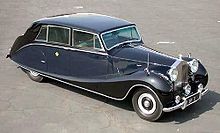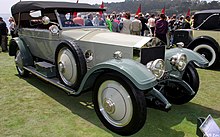Hooper coachbuilders
Hooper & Co. Coachbuilders was a London- based coachbuilder that handcrafted custom bodies for British luxury vehicles until 1959. The company was known for numerous, sometimes extraordinary, bodies for Rolls-Royce chassis , many of which were supplied to the British royal family and also to monarchs of other countries. At times, Hooper took the position of Royal Warrant , i. H. of the royal purveyor to the court . Since the Second World War , Hooper was closely associated with the Daimler Motor Company and became their preferred body manufacturer. When the production of special bodies became more difficult with the introduction of self-supporting bodies at Rolls-Royce, Hooper ceased operations. In the 1980s the name Hooper experienced a brief renaissance.
Company history
The beginnings
The roots of the company were Adams & Hooper, a cartwright- maker company founded in London in 1805 - according to other sources: 1807 - which initially manufactured carriage wagons. Since 1830, Adams & Hooper regularly delivered elaborately designed carriages to the royal family, which were used by the British Queen Victoria and later by King Edward VII .
Royal purveyor to the court
From 1896 the company traded as Hooper & Co Coachbuilders Ltd. A little later the first structure for an automobile was produced. At the beginning of the 20th century, Hooper shifted the focus to car bodies. Here, too, the company concentrated on the luxury class and, from 1908, preferred to equip chassis from Rolls-Royce.
After the First World War, Hooper became the royal purveyor to state limousines. The company benefited from this position and was able to win numerous private customers. Even in difficult economic times, Hooper was able to expand its sales regularly. At the beginning of the 1930s Hooper had three spatially separated production facilities in Chelsea, Blackfriars and Acton; In them Hooper produced up to 300 bodies per year. As early as 1920, Hooper also owned the Bedfordshire-based company Maythorn & Son Ltd. taken over, in which conservatively designed upper-class bodies were manufactured with wooden bodies. When Hooper finally took over competitor Barker & Co. in 1938 , who had been the preferred supplier of Rolls-Royce bodies for several decades, the company had four production facilities. This made him one of the largest British manufacturers of luxury bodies before World War II.
Takeover by BSA and decline

After the beginning of the Second World War, Hooper was taken over by the Birmingham Small Arms Company (BSA), a company primarily active as an arms manufacturer. This step intensified Hooper's relationship with the Daimler Motor Company , a direct competitor of Rolls-Royce, which in turn had belonged to BSA since 1911.
In the 1950s, Hooper mainly bodyed chassis from Daimler. On the basis of the Daimler DB18 / Consort , the Regency and the DK400 , special models were created in small series with bodies in the style of the Hooper Empress Line , which were part of the Daimler factory program as Empress I to IV . Hooper also built similarly designed sedans for Rolls-Royce and Bentley chassis, although the name Empress was not used for them. Outstanding show cars of this era are the so-called Docker Daimler , five exceptionally designed one-offs that were created between 1951 and 1955 on the basis of the large Daimler chassis.
At the end of the 1950s, Hooper got into an economic crisis. Daimler had failed to develop vehicles that could keep up with Rolls-Royce and Bentley . The Daimler models were increasingly viewed as outdated and were no longer attractive, so that the number of new orders for Daimler bodies fell sharply over the years. Hooper was unable to compensate for this decline with additional Rolls-Royce bodies. Here, too, orders fell sharply in the second half of the 1950s: after 40 Rolls-Royce bodies in 1956, 26 bodies were produced in 1958 and only 14 in 1959 for the chassis from Crewe.
In 1959, Hooper was finally informed by Rolls-Royce that the successor to the Silver Cloud planned for the mid-1960s - the Rolls-Royce Silver Shadow - would no longer have a separate chassis, but would have a self-supporting body . Since this made the production of special bodies much more difficult, Hooper saw no long-term prospects of success for the custom body construction. In 1959 the production of car bodies was finally given up.
In 1960 Hooper opened a service and repair shop for vehicles with Hooper bodies; ten years later, the company also got a factory agency for Rolls-Royce and Bentley.
New beginning in the 1980s
In the mid-1980s, Hooper again presented some special bodies for Rolls-Royce vehicles. This includes the Hooper Bentley Empress II , a two-door coupé based on the Bentley Mulsanne , which received a sloping front section and a semi-hatchback. A few copies of the model were made; they were offered from 1987 at a price of 825,000 DM, almost four times the price of a "standard" Bentley Mulsanne. Later, individual extended versions of the Rolls-Royce Silver Spirit and two-door versions of the Bentley Mulsanne were also offered.
The Hooper style
Even before the First World War, Hooper acquired a reputation for designing car bodies that are perfectly tailored to the needs of customers and for carrying out the work with perfect craftsmanship and without considering costs.
Since the 1930s, most of the bodywork has been designed by Osmond Rivers, a skilled plumber who joined the company in 1911. In terms of style, his designs were more elegant than sporty. In later years, however, some designs also deliberately pursued the goal of creating a sensation through unusual design features. These included the Docker-Daimlers.
In the 1950s, many of Rivers' designs were characterized by a sloping rear line on which the trunk appeared to be placed on top. This detailed design was later occasionally described as the "Hooper-Heck". It had a long lasting effect and is now sometimes seen as a trademark of traditional designs:
- The "Hooper rear end" can be found on the Daimler DS420 sedan presented in 1968 , which was not designed by Hooper, but cited elements of classic designs.
- The American automobile designers Bill Mitchell and Wayne Crady took up Hooper's rear design in 1980 for the second series of the Cadillac Seville . By deliberately citing design features of traditional British luxury vehicles and projecting them stylized onto a contemporary design, they created "the most distinctive American automobile since the Tailfin Cadillacs of 1948". They tried to give the smaller but more expensive model from Cadillac additional prestige. The GM competitors Ford and Chrysler followed suit and a little later presented their own vehicles, which also had a "Hooper rear end". These included the Lincoln Continental (1981) and the Chrysler Imperial (1981). They were also high-priced, comparatively compact vehicles.
The Docker-Daimlers
Between 1951 and 1955, Hooper presented an individually designed vehicle based on the large Daimler limousine at the London Motor Show in October each year. The vehicles were intended for Lady Docker, the wife of the BSA chairman. They stood out from the traditional, rather reserved Hooper design and sometimes had very striking lines.
The Docker-Daimlers were:
- Stardust or The Golden Daimler , a sedan (1951)
- Blue Clover , a five-seat sedan (1952)
- Silver Flash , a two-seater coupe (1953)
- Star Dust , a sedan (1954)
- Golden Zebra , a two-door coupé with zebra skin seat covers (1955).
literature
- Nick Walker: AZ of British Coachbuilders . Bay View Books
- Jonathan Wood: Rolls-Royce & Bentley. The story of a legendary brand . 1st edition 2003 Königswinter (Heel Verlag GmbH) ISBN 3-89880-106-3 .
Web links
Individual evidence
- ↑ Company history on the website www.coachbuild.com (accessed on July 26, 2011).
- ^ Wood: Rolls-Royce & Bentley. P. 70.
- ^ Wood: Rolls-Royce & Bentley. P. 70.
- ↑ Company history on the website www.coachbuild.com (accessed on July 26, 2011).
- ^ Wood: Rolls-Royce & Bentley. P. 70.
- ^ Wood: Rolls-Royce & Bentley. P. 71.
- ↑ Illustration of a Hooper Empress II .
- ↑ Auto Catalog No. 31 (1987/88), p. 105.
- ↑ Auto Catalog No. 35 (1991/92), p. 106.
- ↑ Pictures of two-door Mulsanne models from Hooper on the website www.bentleyspotting.com (accessed July 26, 2011).
- ↑ Company history on the website www.coachbuild.com (accessed on July 26, 2011).
- ^ Richard M. Langworth: Encyclopedia of American Cars 1930–1980, p. 94.
- ↑ Brief description of the Docker Daimler with images on the website www.joesherlock.com (accessed on July 26, 2011).



